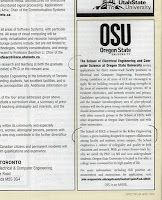PHOTO: cover of newsletter story by Jean-Nickolaus Tretter, "Tretter Collection Makes Purchase of Magnus Hirschfeld Li Family Estate," Tretter Letter, Jan. 2007, p. 1,3 (PDF). See the home page of The Jean-Nickolaus Tretter Collection in Gay, Lesbian, Bisexual and Transgender Studies at the University of Minnesota Elmer L. Andersen Library. Also see The Magnus Hirschfeld Gesellschaft, Berlin, Germany and the Schwules Museum, Germany.
PHOTO: Map to The Jean-Nickolaus Tretter Collection in Gay, Lesbian, Bisexual and Transgender Studies at University of Minnesota, Elmer L. Andersen Library, 222 21st Avenue South, Minneapolis, MN 55455 (Also see Univ. of Minnesota Tretter Collection on Google Maps)
The Jean-Nickolaus Tretter Collection's recent acquisition of Magnus Hirschfeld's estate complements my Magnus Hirschfeld Fund for research concerning humans or animals with a minority sexual orientation or gender identity, which I created at Oregon State University. See my previous posts: Thomas Kraemer, "OSU Foundation Magnus Hirschfeld Fund Agreement," Tom's OSU blog tomsosu.blogspot.com posted Jan. 4, 2012 and my OSU history: Thomas Kraemer, "Corvallis, Oregon State University gay activism 1969-2004," outhistory.org.
Jean-Nickolaus Tretter grew up in Little Falls in a family that first settled in Morrison County in 1848, before Minnesota was a territory. Born in 1946, Tretter had sensed since childhood that he was attracted to men but assumed he had to hide his attraction. However, the Stonewall Riots signaled a new chapter in his life. By April 1972, he was out of the closet and out of the Navy where he had served during Vietnam as a decorated linguist. When Tretter returned to the Twin Cities, he and his friends organized the first Twin Cities commemoration of the Stonewall Riots in June 1972. At around the same time, Tretter began to collect Gay and Lesbian materials in a piecemeal fashion. He didn't start out with the grand scheme of an archive; he just gathered the things that seemed to atter.
Tretter studied social and cultural anthropology at the University of Minnesota from 1973-1976 and wanted to specialize in Gay and Lesbian anthropology but could not get the institutional support he needed. Tretter dropped out of the University and began working as a counselor at a Ramsey County residence for youth with multiple disabilities. He also began studying Gay and Lesbian history on his own, beginning the accumulation of the thousands of books, photos and documents that currently make up his collection.
Tretter has always worked as a visible activist for Gay and Lesbian issues. In 1982, he acted as co-chairman of Minnesota's Gay/Lesbian Olympic Committee and helped assemble the third largest delegation after San Francisco and Los Angeles. Tretter even talked California organizers into diverting their New York to San Francisco torch run into the Twin Cities.
In 1983, Tretter was assembling a Gay history display at St. Paul's Landmark Center when he made a disturbing discovery: "Our Gay history was disappearing as fast as we were producing it." Tretter consciously started collecting anything that was Gay or Lesbian, always on the lookout for new materials. Since 1982, he has been a member of the Los Angeles-based International Gay and Lesbian Archives where he served as both a Board member and the Upper Midwest Representative. Tretter took his growing knowledge of Gay and Lesbian archiving and began to apply it to Minnesota history in earnest.
Because Tretter currently has a larger collection than any other libraries or archives in the area, he is in the ironic position of being a major resource for students getting degrees in Lesbian and Gay studies. Most scholarly sins, explains Tretter, come from cultural biases. "Archaeologists find two graves, one with the remains of a man, one the remains of two women. The traditional interpretation is always that the man had two wives. But suppose it was a Lesbian couple with a male slave? The cultural bias is built in."
Tretter continues to focus the bulk of his attention on strengthening his archives. He is often asked to speak at public events and in university classes on Gay and Lesbian history. For sixteen years he was the host and producer of "Night Rivers," on KFAI, the only regularly broadcast Gay and Lesbian classical music show in the country.
Explains Tretter, "It's important we create a historical legacy to pass along to future generations. It's how the Jews endured thousands of years of persecution, because they had a tradition and a history. I would like to have a part in giving Gays and Lesbians of the future something similar to hold on to." (Quoted from "About Jean-Nickolaus Tretter," special.lib.umn.edu/rare accessed Jan. 20, 2012)
Below is a complete list of links to the PDF newsletters from Jean-Nickolaus Tretter before he went on medical leave and my notes about interesting things I read in each newsletter:
- Tretter Letter, University of Minnesota Libraries, Jan. 2006 -- Magnus Hirschfeld collection is mentioned on p. 3, 7-8. See The Magnus Hirschfeld (reduced) exhibit online, The Magnus Hirschfeld Gesellschaft, Berlin, Germany and the Schwules Museum.
- Tretter Letter, University of Minnesota Libraries, Jun. 2006 -- the gay Log Cabin Republicans material was acquired by the Tretter Collection. Oregon State University Professor W. Dorr Legg was the founder of the Log Cabin Republicans. See my blog post: Thomas Kraemer, "W. Dorr Legg OSU archives records 1935-1942," thomaskraemer.blogspot.com posted Jul. 31, 2010
- Tretter Letter, University of Minnesota Libraries, Jan. 2007 -- explains how Magnus Hirschfeld's travelling exhibit material was spared when the Nazis burned his library May 10, 1933. Hirschfeld took the material into exile in Nice, France and it was inherited by his lover Li Shiu Tong who kept the material until passing it on to his family that later donated it to University of Minnesota, The Jean-Nickolaus Tretter Collection in Gay, Lesbian, Bisexual and Transgender Studies, Elmer L. Andersen Library. Their acquisition of Magnus Hirschfeld's collection complements my Magnus Hirschfeld Fund for research concerning humans or animal s with a minority sexual orientation or gender identity that I created at Oregon State University. See my pervious post: Thomas Kraemer, "OSU Foundation Magnus Hirschfeld Fund Agreement," Tom's OSU blog tomsosu.blogspot.com posted Jan. 4, 2012
- Tretter Letter, University of Minnesota Libraries, Jun. 2007 -- the parents of Neil Isbin (born 1954, died Aug. 9, 1996) set up an endowment for the Tretter Collection in their son's name. Also see next issue below.
- Tretter Letter, University of Minnesota Libraries, Jan. 2008 -- "Friends of Dorothy" endowment p. 5, 7 announcement. Neil Isbin passed away from AIDS related illness (See previous issue above).
- Tretter Letter, University of Minnesota Libraries, Jun. 2008 -- Magnus Hirschfeld p. 2, 5-6 shows a charred book rescued from the rubble of the Hirschfeld library after the Nazis burned it down in 1933
- Tretter Letter, University of Minnesota Libraries, Jan. 2009 -- p. 4 University of Minnesota Professor of History Allan Spear was a key gay leader at the U of M died Oct. 11, 2008 at age 71 after a 36 year-long career. As a state representative he broke ground as one of the first openly gay politicians in America. When I first met him in 1973, I found him to be very opinionated and focused on making things happen.
- Tretter Letter, University of Minnesota Libraries, Jun. 2009
In the early 1970s, Jack Baker was a University of Minnesota law student who became a famous gay activist for getting legally married (Minnesota state law did not specify gender back then) and then taking his contested gay marriage case all the way to the U.S. Supreme Court, which dismissed it in 1972 for "lack of a substantial federal question." Here are some links to more about Jack Baker and gay marriage:
- Thomas Kraemer, "Jack Baker & Michael McConnell: Lunatics or Geniuses?" GayToday.com posted June 21, 2004 (NOTE: This link goes to the original Web site that the article was posted on) -- my view of how mainstream gay activists rejected Jack Baker's gay marriage goal as being contrary to the goals of gay liberation and sexual liberation
- Ken Bronson, "A Quest for Full Equality," www.may-18-1970.org self-published May 18, 2004 (PDF) NOTE: This URL links to the original PDF stored on Ken Bronson's Web site www.may-18-1970.org about Jack Baker's marriage. Ken Bronson's Web site appears to be dead circa 2011. For a certified archived copy go to the Internet Archive Way Back Machine to view a copy of the Contents Page for www.may-18-1970.org that has a link to a PDF copy of the Jack Baker history by Ken Bronson. Or try Ken Bronson, "A Quest for Full Equality," www.may-18-1970.org self-published May 18, 2004 (PDF 1.4MB) ( NOTE: This links to my private local copy of the PDF that is not available to be publically linked to due to copyright and limited server bandwidth and space.)
Thomas Kraemer's previous blog posts on Jack Baker and gay marriage activism:
- Life Magazine gay marriage 1971 (11/20/08) -- a mass circulation magazine features Jack Baker's gay marriage
- Newsweek gay marriage religious case (12/10/08)
- Sunday paper gay marriage advice (1/12/09)
- Jack Baker gay marriage theory was right (4/28/09)
- Obama wrong on Baker v. Nelson gay marriage case (6/13/09)
- Jack Baker GAY cover 1971 (7/18/09)
- Baker v. Nelson 1972 Supreme Court order on gay marriage (7/22/09)
- Jack Baker 1971 Look magazine gay marriage story (7/23/09)
- Arthur S. Leonard on Baker v Nelson gay marriage case (7/28/09)
- Jack Baker case still cited to bar gay marriage (3/12/11)
The connection between Magnus Hirschfeld, Jack Baker, University of Minnesota and Oregon State University amazes me.








